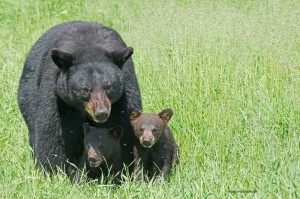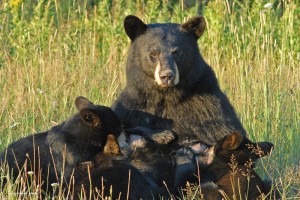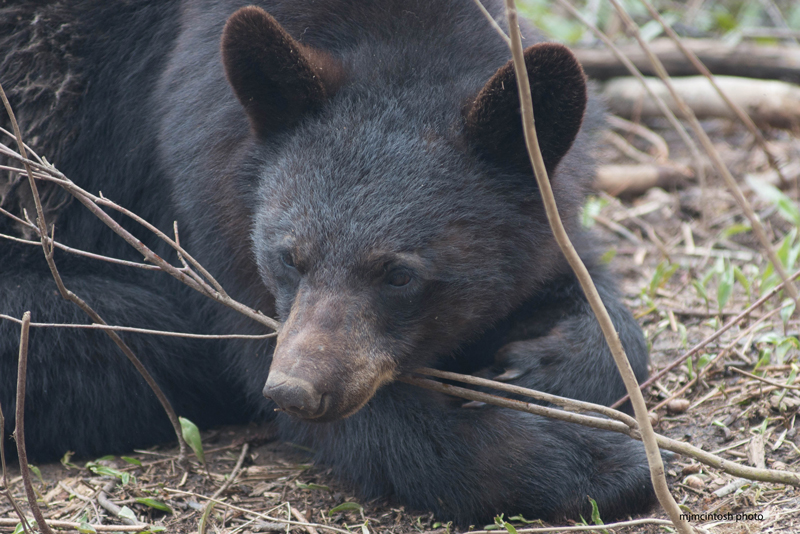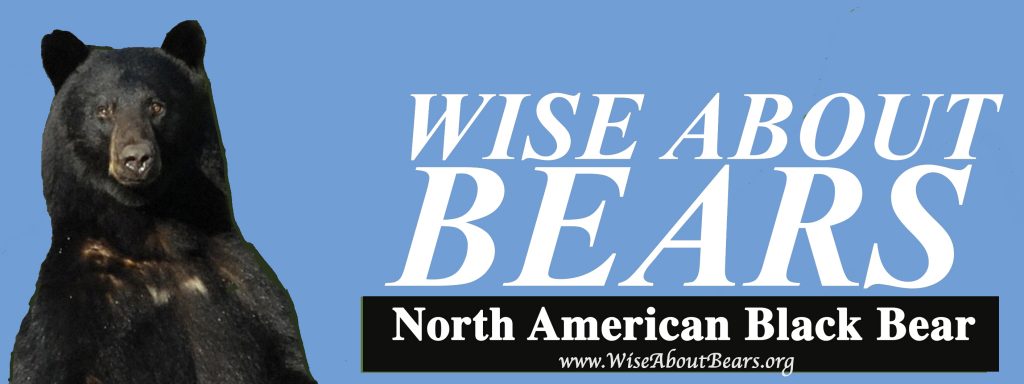Black Bear Mother Nursing Cubs. See and hear bear cubs nursing.
When a mother black bear leads her cubs away from a den, her usual destination is a big tree where the cubs can take refuge from danger. That tree is typically a white pine over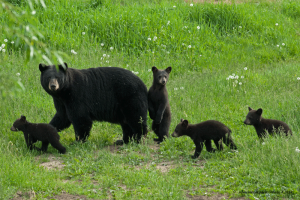 21 inches in diameter. A mother may pass by many other trees to reach a big pine where she will rake a bed at the base for herself and the cubs. She seems to know where each big white pine is in her territory. Big white pines have strong, rough bark cubs can safely climb. Their needles give shade, and the branches are strong enough to hold whole families if need be. Mothers leave their cubs at these “baby-sitter” trees and forage nearby, occasionally up to two miles away. The cubs sleep hidden in the crowns or play around the base, ready to climb at any hint of danger. If disturbed, they may remain quiet up the tree or yell in distress, bringing mothers running, grunting with concern. Mothers with cubs continue to seek out the safety of big white pines throughout spring and summer, making 92 percent of their beds at the bases of them (Ely MN.). Other bears give more consideration to comfort, shade, and water than to the security of white pines.
21 inches in diameter. A mother may pass by many other trees to reach a big pine where she will rake a bed at the base for herself and the cubs. She seems to know where each big white pine is in her territory. Big white pines have strong, rough bark cubs can safely climb. Their needles give shade, and the branches are strong enough to hold whole families if need be. Mothers leave their cubs at these “baby-sitter” trees and forage nearby, occasionally up to two miles away. The cubs sleep hidden in the crowns or play around the base, ready to climb at any hint of danger. If disturbed, they may remain quiet up the tree or yell in distress, bringing mothers running, grunting with concern. Mothers with cubs continue to seek out the safety of big white pines throughout spring and summer, making 92 percent of their beds at the bases of them (Ely MN.). Other bears give more consideration to comfort, shade, and water than to the security of white pines.
Dealing with Water in the Den. Water in dens is a problem, especially for mothers with cubs. Newborn cubs that are too young to walk in January, February, or early March can be killed from exposure or drowning if there is an early melt or hard rain. By mid-March, cubs have enough fur and mobility to deal with wetness with help from their mothers. Some cubs take refuge on their mothers’ backs. Sometimes, the whole family can find a drier spot in the den. Melt water that drips on cubs is licked off by the mothers.If a den is flooded, mothers sometimes evacuate the cubs by carrying them in their mouths, one at a time, where snow is too deep for the cubs to walk. Other families have moved outside until their dens dried out and then moved back inside.Female 320 found a different solution when melt water soaked the floor of her den in a cave near Ely on March 12-15, 1973. She bit branches off spruce saplings and brought them into the den to raise herself and her three cubs above the water.During a thaw in March 2007, water seeped into 6-year-old June’s den. She moved her cubs to a bed on top of the den and licked them dry. The family remained in this bed for a week. They returned to the den when cold weather returned.
Cub Vocalizations – Mother Responses: Because bears are intelligent animals, much of their behavior is based on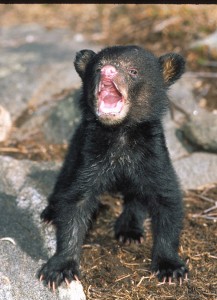 learning rather than instinct, so responses may vary. Vocalization – Situation – Mother’s Response Pulsating hum – Nursing (or, rarely, when warm and comfortable) – Mother maintains position. Crying – Underneath mother in den but can’t reach nipples – Mother changes position. Cub in den needs to defecate Mother licks the cub’s anus and eats the feces. Cub exposed to cold in the den Mother uses the paw, chin, or mouth to tuck cub beneath her. .Cub is cold in snow outside the den Mother rolls over and lets the cub climb onto her belly and snuggle against the skin between her hind legs. She draws her legs up around the cub and covers it. Bawling – Cub wants to nurse – Mother may comply or not. Cub wants ant colony or other food the mother has found, Mother usually allows the cub to eat. Cooing – Cub separated from mother – Mother may come or not. Yelling – Cub separated from mother – Mother grunts with concern and returns to cub. Screaming – Cub in danger – Mother comes running and may bluff-charge a nearby person, attack an intruding bear, or retreat.
learning rather than instinct, so responses may vary. Vocalization – Situation – Mother’s Response Pulsating hum – Nursing (or, rarely, when warm and comfortable) – Mother maintains position. Crying – Underneath mother in den but can’t reach nipples – Mother changes position. Cub in den needs to defecate Mother licks the cub’s anus and eats the feces. Cub exposed to cold in the den Mother uses the paw, chin, or mouth to tuck cub beneath her. .Cub is cold in snow outside the den Mother rolls over and lets the cub climb onto her belly and snuggle against the skin between her hind legs. She draws her legs up around the cub and covers it. Bawling – Cub wants to nurse – Mother may comply or not. Cub wants ant colony or other food the mother has found, Mother usually allows the cub to eat. Cooing – Cub separated from mother – Mother may come or not. Yelling – Cub separated from mother – Mother grunts with concern and returns to cub. Screaming – Cub in danger – Mother comes running and may bluff-charge a nearby person, attack an intruding bear, or retreat.
Family Break-Up~
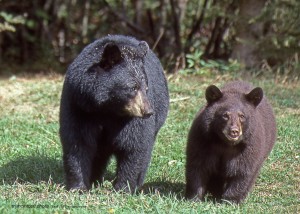 It happens every May or June without fail, and to human beings, who tend to attach human emotions onto things, it sounds and looks like a cruel and heartbreaking occasion. But to bear families, it is a normal and necessary happening. The moms push the yearlings out of their lives for good, in favor of a far greater interest in finding a mate when they come into estrus when the yearlings are about 16-17 months old.
It happens every May or June without fail, and to human beings, who tend to attach human emotions onto things, it sounds and looks like a cruel and heartbreaking occasion. But to bear families, it is a normal and necessary happening. The moms push the yearlings out of their lives for good, in favor of a far greater interest in finding a mate when they come into estrus when the yearlings are about 16-17 months old.
However, the frightened young bears soon discover that Mom has prepared them well for living on their own. Once their initial confusion is overcome, they quickly begin developing confidence in themselves and become self-sufficient. And so the life cycle of the black bear continues.
.
“Black bear mothers give birth in January and stay with their cubs for 16-17 months.
.
“Family bonds remain strong right up to the day of family breakup. In the days before family breakup, they play together,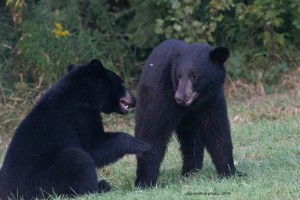 groom each other, sleep together, and suckle. Like human youngsters, yearling bears sleep very soundly, trusting their safety to the alertness of their mother.
groom each other, sleep together, and suckle. Like human youngsters, yearling bears sleep very soundly, trusting their safety to the alertness of their mother.
.
“Family breakup happens suddenly during mating season in May or June when the mother is nearly ready to mate.
.
“The sudden presence of a male can precipitate family breakup. At first, the mother is torn between her yearlings and the persistent male, but within a day after family breakup, she will chase her yearlings away whenever she encounters them.
.
“Littermates may also separate from each other. Each settles in a separate area within its mother’s territory. The mother then avoids those areas, giving the yearlings nearly exclusive feeding rights.
.
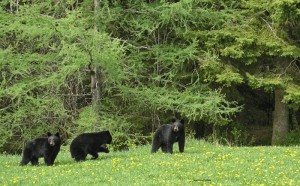 “Without their mothers, the yearlings are initially skittish, spending long periods up trees. By the end of the summer, they develop into confident little bears. Most sons voluntarily leave within a couple years after family breakup. Most daughters eventually establish territories in or near their mother’s territory.”
“Without their mothers, the yearlings are initially skittish, spending long periods up trees. By the end of the summer, they develop into confident little bears. Most sons voluntarily leave within a couple years after family breakup. Most daughters eventually establish territories in or near their mother’s territory.”
.
“Family breakup happens in different ways in different families and in different years. Sometimes, the mother comes into estrus, separates from her yearlings, and begins 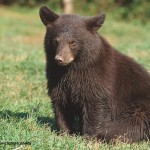 roaming—laying down scent trails for males to follow. In other cases, families may separate, reunite, and separate again permanently.
roaming—laying down scent trails for males to follow. In other cases, families may separate, reunite, and separate again permanently.
The above information is courtesy of Dr Lynn Rogers, Sue Mansfield and Team. They have carried out bear research that gives people an insight into a bears life, especially how caring and attentive a mother bear is. Thank you Dr Rogers and Team for this. Visit the North American Bear Center at: http://www.bear.org
Photographs – Mike McIntosh

